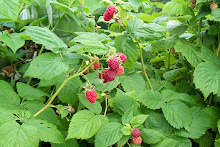Companion planting is something I've been fooling around with for the last couple of years. The idea behind it is great. You group plants together to discourage pests and disease and/or encourage growth and bounty. I find it very appealing especially since I don't use any chemical pesticides, herbicides or growth boosters. And, of course, it has that key word that is all the buzz these days 'sustainability'. I'm still learning and I'm not anywhere close to being successful all of the time.
If nothing else, companion planting makes for an interesting looking garden. When the plants first start coming up, all different and random it really looks like some great giant came and sneezed seeds instead of snot all over my garden. The year before this one, I dotted the garden with sunflowers and nastriums to help with pest control. I don't know if it made any difference discouraging bugs but I think I'll do that again next year. After getting past the giant sneeze stage,it looked really nice.
Carrots and Green/Yellow Beans
The only problem I ever had with carrots was with slugs one year when I planted them where herb garden is now using the "square foot method". The slugs had a field day and I had no carrots. Haven't tried the square foot method since.I just plant them in the main garden and the slugs don't plow through them. So planting carrots and beans together was an experiment in increased harvest. I planted the combo near the front of the garden, towards the end. Things generally do pretty well there. I used bush bean seeds and three types of carrot seed. Baby carrot, Chantenay and a longer carrot type I can't remember the name of (naturally, because that's the one that worked the best). The scheme worked really well. It might have increased the bean production but there was a definite advantage for the carrots. I got a good bean yield and once harvested and the plants pulled up, the carrots had a lot more growing room. I think the carrots don't need to be thinned at all because of the extra room they get. The carrot yield was the best and the carrots were a great size and shape. So I will definitely keep with this companion planting duo. I don't think I'll use the Chantenay again even though it is a heirloom plant because they're squat, very thick and not all the easy to freeze compared to the longer, thinner carrot that I can't remember the name of.
Two (green) thumbs up for bush beans and baby and longer carrots.
Lettuce and Onions
In short, this did not work well. I planted two different types of onion; yellow, which I have had great success with in the past and red onions, something new for me. I usually buy the mild mesclun mix lettuce. This year I tried some other mixes and "gourmet" blends I planted them next to the beans and carrots with the Swiss chard (which did amazing) on the high end of the garden in the front. The onions were dismal, both types, few and far between and really, really small. I'm already through them all, last year they lasted well into February if not March. The lettuce did OK but certainly not the bonus crops I've had previously. I planted them in a different place, may-be that had something to do with it. May-be the onion seeds weren't good. May-be the moon phase wasn't right. May-be I'm grasping at straws. I think next year, I'll really pay attention to the onion seed I buy. The year before, I bought a bag of 100 and got at least 200, this year the 100 was barely 80, both types. Now thinking about it, I did plant some nastriums near the onions last year and that crop was great. Something to remember for next year. And I'll go back to the mesclun lettuce mix. Now, if I could only remember the name of that carrot I liked so much...
So two (gritty) clumps of dirt for this experiment.
It's Time for a new Free Store!!
1 week ago

No comments:
Post a Comment